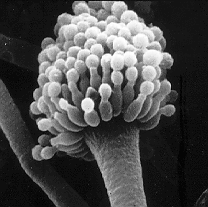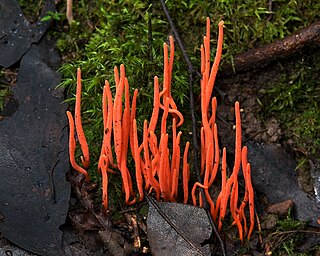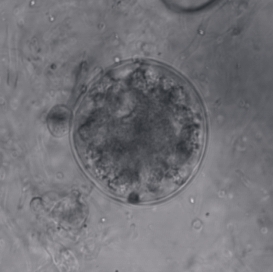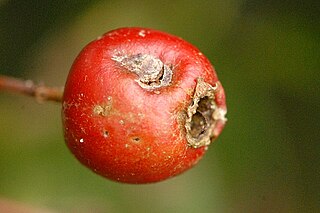Related Research Articles

The Russulales are an order of the Agaricomycetes,. According to the Dictionary of the Fungi, the order consists of 12 families, 80 genera, and 1767 species. According to Species Fungorum, the order contains 13 families, 117 genera, and 3,060 species.

The Eurotiales are an order of sac fungi, also known as the green and blue molds. The order contains three families, 49 genera, and 928 species. It was circumscribed in 1980.

The Hymenochaetales are an order of fungi in the class Agaricomycetes. The order in its current sense is based on molecular research and not on any unifying morphological characteristics. According to one 2008 estimate, the Hymenochaetales contain around 600 species worldwide, mostly corticioid fungi and poroid fungi, but also including several clavarioid fungi and agarics. Species of economic importance include wood decay fungi in the genera Phellinus and Inonotus sensu lato, some of which may cause losses in forestry. Therapeutic properties are claimed for Inonotus obliquus ("chaga") and Phellinus linteus, both of which are now commercially marketed.

The Clavariaceae are a family of fungi in the order Agaricales. Collectively, they are commonly known as coral fungi due to their resemblance to aquatic coral, although other vernacular names including antler fungi, finger fungi, worm mold, and spaghetti mushroom are sometimes used for similar reasons.

Helotiales is an order of the class Leotiomycetes within the division Ascomycota. According to a 2008 estimate, the order contains 10 families, 501 genera, and 3881 species.

Spizellomycetales is an order of fungi in the Chytridiomycetes. Spizellomycetalean chytrids are essentially ubiquitous zoospore-producing fungi found in soils where they decompose pollen. Recently they have also been found in dung and harsh alpine environments, greatly expanding the range of habitats where one can expect to find these fungi.

Members of the Monoblepharidomycetes have a filamentous thallus that is either extensive or simple and unbranched. They frequently have a holdfast at the base. In contrast to other taxa in their phylum, some reproduce using autospores, although many do so through zoospores. Oogamous sexual reproduction may also occur.

The Venturiaceae are a family of fungi in the order Pleosporales. Several of the species in this family are plant pathogens.

The Pleosporales is the largest order in the fungal class Dothideomycetes. By a 2008 estimate it contains 23 families, 332 genera and more than 4700 species. The majority of species are saprobes on decaying plant material in fresh water, marine, or terrestrial environments, but several species are also associated with living plants as parasites, epiphytes or endophytes. The best studied species cause plant diseases on important agricultural crops e.g. Cochliobolus heterostrophus, causing southern corn leaf blight on maize, Phaeosphaeria nodorum causing glume blotch on wheat and Leptosphaeria maculans causing a stem canker on cabbage crops (Brassica). Some species of Pleosporales occur on animal dung and a small number occur as lichens and rock-inhabiting fungi.

Diaporthales is an order of sac fungi.

The Hysteriaceae are a taxonomic family of fungi and the only extant family of the order Hysteriales. Members of the Hysteriaceae are defined by the possession of a sexual structure called the hysterothecium, an elongated structure that opens by a longitudinal slit and releases sexually produced spores. The family is widely distributed, with many species found in temperate regions, and most are saprobic on wood and bark, although a few are parasitic on plants.
The Phaeosphaeriaceae are a family of fungi in the order Pleosporales. Species in the family have a cosmopolitan distribution, and are generally nectrotrophic or saprobic on a wide range of plants.
The Pleomassariaceae are a family of fungi in the order Pleosporales. Taxa have a widespread distribution in both temperate and tropical regions, and are saprobic or necrotrophic on wood, bark, and other herbaceous material.
Howard Elson Bigelow was an American mycologist, born in 1923 in Greenfield, Massachusetts, and died in 1987. He was wed to mycologist Margaret Elizabeth Barr-Bigelow in 1956. He studied at Oberlin College from 1941 to 1943. He left college to fight in the American army. He returned to Oberlin after the war and obtained his Bachelor of Arts in 1949 and his Master of Arts in 1951. He studied botany at the University of Michigan under the guidance of Alexander Hanchett Smith (1904–1986) and received his doctorate in 1956. Bigelow and his wife worked for University of Massachusetts from 1957 to his death. He is the author of works on the fungi of the genus Clitocybe and the family Tricholomataceae.

The Microascales are an order of fungi in the class Sordariomycetes, subclass Hypocreomycetidae. This is a relatively small order of mostly saprobic fungi that live in soil, rotting vegetation and dung. Some species are plant pathogens, such as Ceratocystis fimbriata, transmitted by beetles to living trees and causing cacao wilt and many other economically important diseases. Species in the genus Pseudallescheria are pathogenic to humans, for example, Pseudallescheria boydii can cause allergic bronchopulmonary disease. The order was circumscribed in 1980.
Jobellisia is a genus of fungi within the family Jobiellaceae, class Sordariomycetes. The genus was circumscribed by Margaret Elizabeth Barr-Bigelow in 1993 with J. luteola as the type species. It contains species that grow on dead wood and bark in tropical and temperate regions of the Northern Hemisphere.

The Leptosphaeriaceae are a family of fungi in the order Pleosporales. The family was circumscribed by mycologist Margaret E. Barr in 1987. According to the Dictionary of the Fungi, the family contains 8 genera and 302 species. The family has a widespread distribution, but is especially prevalent in temperate regions. Species are either saprobic or grow as nectrotrophs on the stems or leaves of plants.
Margaret Elizabeth Barr-Bigelow is a Canadian mycologist known for her contributions to the Ascomycetes fungi.
Catenochytridium is a genus of fungi in the family Endochytriaceae. The genus contains six species known from Japan and North America.
Endochytrium is a genus of fungi in the family Endochytriaceae. The genus is widespread in temperate regions, and contains seven species.
References
- ↑ Kirk PM, Cannon PF, Minter DW, Stalpers JA (2008). Dictionary of the Fungi (10th ed.). Wallingford, UK: CAB International. p. 232. ISBN 978-0-85199-826-8.
- ↑ Barr DJS. (1980). "An outline for the reclassification of the Chytridiales, and for a new order, the Spizellomycetales". Canadian Journal of Botany. 58 (2): 2380–94. doi:10.1139/b80-276.